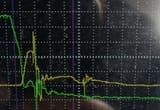Search Results
7/21/2025, 1:04:36 PM
>>2933056
>protects from shorts
Yes, half of the function is short protection. It would be real bad news to accidentially charge the inductor for arbitary time.
But it also has a function similar to the R in RC generators. The |Z| of the C is very different for the transient than it is for the ~DC. So you have a capacitive-resistive divider that allows for the full output voltage to appear on the inactive gap and then allows full current flow when the transient happens.
The R in RC does something similar, just at a fixed value while only the gap changes from high to low impedance. Without the RCs R the spark once struck would burn indefinately. So it allows charging when gap is high impedance and allows snuffing the spark when gap is low impedance. Too low of an R in RC and you got an arc. Arc =/= spark.
It rings badly and I have experiments planned to add a second transistor that switches the return path and gets punished in funny ways.
>did you blow up
next posts picrel will give an indication of blown up things
>you can't use most gate drive chips
Why not? I have lots of discrete gate drivers sitting here because beyond certaon gate current you just need to DIY. Bur the final product will have a gate driver. And it's just going rail to rail between the voltages you give it.
>Advantages of EDM
VERY hard materials, very brittle materials, microscopic features and very complex geometries that no odd shaped boring bar will ever reach, without flexing / breaking. That's about it. It's messy, uses 1e3 or more of the power needed for conventional operations, takes ages and making the electrode alone can be expensive and many jobs require several identical electrodes.
Check G-EDM on git. The guy purged his YT lately. But what he is really developing is addon HW for W-EDM on 3dp.
>protects from shorts
Yes, half of the function is short protection. It would be real bad news to accidentially charge the inductor for arbitary time.
But it also has a function similar to the R in RC generators. The |Z| of the C is very different for the transient than it is for the ~DC. So you have a capacitive-resistive divider that allows for the full output voltage to appear on the inactive gap and then allows full current flow when the transient happens.
The R in RC does something similar, just at a fixed value while only the gap changes from high to low impedance. Without the RCs R the spark once struck would burn indefinately. So it allows charging when gap is high impedance and allows snuffing the spark when gap is low impedance. Too low of an R in RC and you got an arc. Arc =/= spark.
It rings badly and I have experiments planned to add a second transistor that switches the return path and gets punished in funny ways.
>did you blow up
next posts picrel will give an indication of blown up things
>you can't use most gate drive chips
Why not? I have lots of discrete gate drivers sitting here because beyond certaon gate current you just need to DIY. Bur the final product will have a gate driver. And it's just going rail to rail between the voltages you give it.
>Advantages of EDM
VERY hard materials, very brittle materials, microscopic features and very complex geometries that no odd shaped boring bar will ever reach, without flexing / breaking. That's about it. It's messy, uses 1e3 or more of the power needed for conventional operations, takes ages and making the electrode alone can be expensive and many jobs require several identical electrodes.
Check G-EDM on git. The guy purged his YT lately. But what he is really developing is addon HW for W-EDM on 3dp.
Page 1
